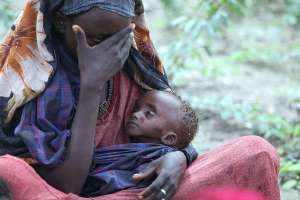
A Somalian mother and her child. Credit: Gallo Images
As I write this, Somalia is suffering its worst drought in 60 years. The lack of rain—combined with civil unrest and political interference from the al-Qaeda linked al-Shabab group—has produced catastrophic results. Yesterday Nancy Linborg, an official with the U.S. Agency for International Development (USAID), told a Congressional committee that more than 29,000 children under the age of 5 had died over the past three months in Somalia, thanks to the famine. If conditions worsen—and there’s little reason to expected that they won’t—upwards to 800,000 children may die of hunger and other causes.
The violent political situation on the ground has multiplied the effect of the famine, preventing UN and other aid groups from helping the starving. But the drought itself is crippling—rainfall over the Horn of Africa, which includes Somalia, Ethiopia and Kenya in East Africa, between February and July 2011 has been 2 to 8 inches below normal, as this map from the National Oceanic and Atmospheric Administration shows:
More from TIME: Escaping from Somalia’s Famine into a Perilous Refuge
![]() It’s always difficult to tell what might be driving extreme weather events like the Horn of Africa drought. Climate change is often fingered as the culprit, but the 2007 report from the Intergovernmental Panel on Climate Change actually predicted that East Africa would receive more rainfall as temperatures warmed, not less.
It’s always difficult to tell what might be driving extreme weather events like the Horn of Africa drought. Climate change is often fingered as the culprit, but the 2007 report from the Intergovernmental Panel on Climate Change actually predicted that East Africa would receive more rainfall as temperatures warmed, not less.
Most immediately, the current drought seems connected to severe drying conditions resulting from the La Nina phenomenon that lasted from June of last year to this May in the Pacific Ocean, and which be connected to record-breaking drought in Texas as well. But according to a new study published today in Science, La Nina—and the its warm counterpart El Nino—has affected the climate of faraway East Africa for at least 20,000 years. A group of scientists from Germany, Switzerland, the U.S., the Netherlands and Belgium examined sediments that have built up over thousands of years in Lake Challa, at the base of Mt. Kilimanjaro in Kenya, drilling into the ground—much as climate researchers use ice cores in Greenland or Antarctica to reveals details about the state of the climate in the Earth’s past.
More from TIME: Famine in Somalia
The researchers found that samples cores had a pattern of stripes, called annual laminae, and that each individual layer could show changes in the region’s climate over the past. Lead author Christian Wolff of the University of Potsdam explains what that means:
During La Niña, rainfall is sparse and the winds over Lake Challa are strong. The winds enhance upwelling of nutrients, intensifying the seasonal blooms of algae. After dying and sinking, they form thick layers of light-colored sediments. During El Niño events, on the other hand, rainfall is frequent and the winds are weak, resulting in thinner white layers in the sediment.
The sediments show that the climate of East Africa has changed drastically over the past 21,000 years, with the last 3,000 years being wetter than average, albeit with long periods of sustained drought. It’s a reminder that this part of the world has a history of massive droughts—droughts far worse than anything we’ve experienced—in the relatively recent past, well before humans began mucking up the climate with greenhouse gases.
That’s not to argue that global warming won’t have a dangerously destabilizing impact on rainfall and hunger in this part of the world, only that climate isn’t as stable as it seems—and we may have some nasty surprises in front of us, whether or not we can quickly curb carbon emissions. Add in rapid population growth—neighboring Ethiopia is growing at more than 3% a year—and political instability, and we can be sure that this horrible famine won’t be the last, or the worst.
More from Ecocentric: When Do We Declare a Famine?
Bryan Walsh is a reporter at TIME. Find him on Twitter at @bryanrwalsh. You can also continue the discussion on TIME’s Facebook page and on Twitter at @TIME


